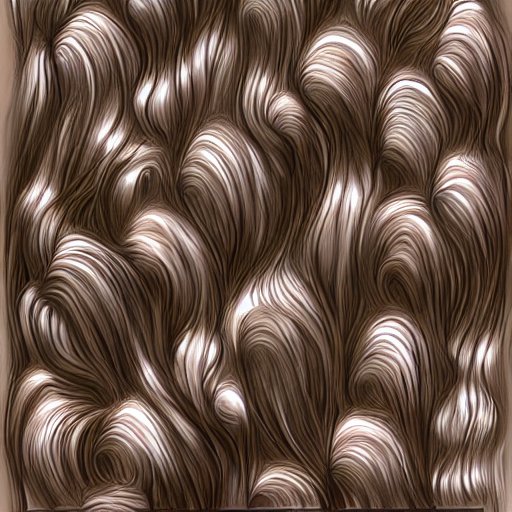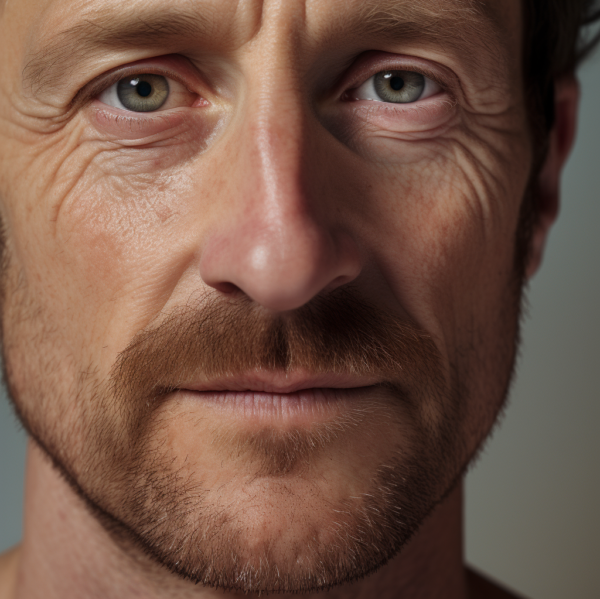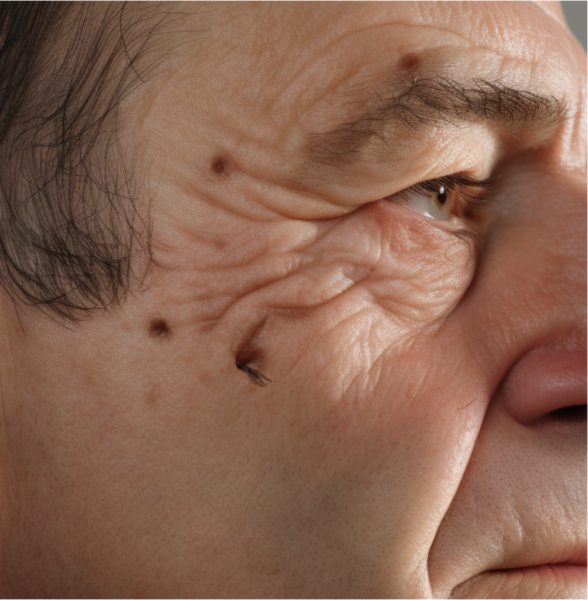The primary component of hair fiber is keratin, a type of protein, which consists of long chains (polymers) of amino acids. The keratin in hair is organized into a rope-like structure known as intermediate filaments. These structures form a complex called the hair shaft, which is the visible part of the hair.
Keratin proteins form the cytoskeleton (miniature skeleton within a cell) of all epidermal cells. Keratin filaments run within a cell from the inside of the outer membrane to weave a “basket” around the nucleus of the cell. Keratins are a principal part of the cells in the epidermis, hair, nails, feathers, hooves, horny tissues, and the enamel of teeth. Keratin accounts for 30% of the cellular protein of living epidermal cells and 85% of cellular protein of the dead cells in the stratum corneum (the scaly, dead or horny layer of the outer skin).
The hair shaft for terminal scalp hairs consists of three layers with keratin incorporated into each of the medulla (in the very center of the hair fiber), cortex (the bulk of the fiber) and cuticle (the outer protective layer of the hair fiber). In hair, keratin proteins comprise 65-95% of the total fiber by weight. Each molecule of keratin is very small – about 10 nanometers across. To give you a sense of how small that is, 10,000 keratin molecules lined up side by side would cover the width of the average terminal scalp hair.
There are several subtypes of keratin proteins, some are called “soft” keratins and others are “hard” keratins. Basically, soft keratins are found in the skin and are relatively easy to break down whereas hard keratins are very resistant to degradation. Hard keratins do not dissolve in water and they are highly resistant to proteolytic enzymes. As you might have guessed, hair fiber is mostly made from hard keratin proteins.
Hair contains a high amount of sulfur (sulphur) because the amino acid cysteine is a key component of the keratin proteins in hair fiber. The sulfur in cysteine molecules in adjacent keratin proteins link together in disulfide chemical bonds. These disulfide bonds are very strong and very difficult to break apart. These disulfide chemical bonds linking the keratins together are the key factor in the durability and resistance of hair fiber to degradation under environmental stress.
Disulfide bonds are largely resistant to the action of acids, but they can be broken apart by alkali solutions. This property is exploited in perms and chemical hair straightening processes. Alkali is used to break the disulfide bonds in the keratins and make the hair weak. The hair is formed into a new shape and then acid is applied to neutralize the alkali and enable the disulfide bonds to reform. The reformed disulfide bonds hold the hair in its new shape. This process isn’t perfect however, and the hair is never quite as strong as the original. Exposure to high temperatures (like those from flat irons or hair dryers) or permanent hair dyes can also damage the keratin structure in the hair, leading to weakened, brittle hair and split ends.
In addition to sulfur from cysteine, other trace elements like zinc, copper, and selenium also play important roles in the structural stability of the hair shaft. Deficiency of these elements could potentially affect hair health and growth. Eating keratin does not aid hair growth, as these keratins are hard for the body to breakdown and absorb. Hard keratins, in particular, simply pass straight through the gut undigested. Rather, a well-balanced diet rich in protein, vitamins, and minerals contributes to overall hair health. Nutrients like biotin, vitamin E, and omega-3 fatty acids, for example, have been associated with improving hair quality. Hair follicle cells will take nutrients supplied via the blood vessels and form the keratin they require.
There are numerous hair products on the market that contain keratin, with claims that they strengthen hair or stimulate hair growth. However, it’s important to understand that hair follicles naturally produce all the keratin they need from amino acids delivered via the bloodstream. While the application of topical keratin products directly to hair might not have enduring effects due to the temporary nature of the treatment and the fact that much of the applied keratin is removed during shampooing, there are some procedures that utilize keratin for more pronounced temporary results.
A common example is the keratin treatment, also known as a Brazilian keratin treatment or keratin smoothing treatment. These popular salon procedures aim to fill the porosity of hair, thereby reducing frizz and providing a smoother appearance. Despite the noticeable temporary improvement effects, these procedures come with potential drawbacks, such as exposure to formaldehyde, a common ingredient in the process. So, while keratin-infused products and treatments can offer temporary aesthetic enhancements, their effects are often short-lived due to the nature of the hair growth cycle and regular washing routines.
Bibliography
11711645 {11711645:C83VIQVI},{11711645:3I7HBQX8},{11711645:FAT4XPND},{11711645:ME857N9F},{11711645:KTM7QJE4},{11711645:MRB6J9KS},{11711645:USRIW23M},{11711645:2TXCIMQW},{11711645:4KVMHIM3},{11711645:5FT438G6},{11711645:V8JE8ITP},{11711645:BN7ENNC7},{11711645:4H4XZDZH},{11711645:I7HCG747} vancouver 50 date asc 462 https://www.keratin.com/wp-content/plugins/zotpress/ %7B%22status%22%3A%22success%22%2C%22updateneeded%22%3Afalse%2C%22instance%22%3A%22zotpress-73e4d3d2c77a096c4765872192086e0b%22%2C%22meta%22%3A%7B%22request_last%22%3A0%2C%22request_next%22%3A0%2C%22used_cache%22%3Atrue%7D%2C%22data%22%3A%5B%7B%22key%22%3A%22I7HCG747%22%2C%22library%22%3A%7B%22id%22%3A11711645%7D%2C%22meta%22%3A%7B%22creatorSummary%22%3A%22Bradbury%22%2C%22parsedDate%22%3A%221973%22%2C%22numChildren%22%3A0%7D%2C%22bib%22%3A%22%3Cdiv%20class%3D%5C%22csl-bib-body%5C%22%20style%3D%5C%22line-height%3A%201.35%3B%20%5C%22%3E%5Cn%20%20%3Cdiv%20class%3D%5C%22csl-entry%5C%22%20style%3D%5C%22clear%3A%20left%3B%20%5C%22%3E%5Cn%20%20%20%20%3Cdiv%20class%3D%5C%22csl-left-margin%5C%22%20style%3D%5C%22float%3A%20left%3B%20padding-right%3A%200.5em%3B%20text-align%3A%20right%3B%20width%3A%201em%3B%5C%22%3E1.%3C%5C%2Fdiv%3E%3Cdiv%20class%3D%5C%22csl-right-inline%5C%22%20style%3D%5C%22margin%3A%200%20.4em%200%201.5em%3B%5C%22%3EBradbury%20JH.%20The%20structure%20and%20chemistry%20of%20keratin%20fibers.%20Adv%20Protein%20Chem.%201973%3B27%3A111%26%23x2013%3B211.%3C%5C%2Fdiv%3E%5Cn%20%20%20%3C%5C%2Fdiv%3E%5Cn%3C%5C%2Fdiv%3E%22%2C%22data%22%3A%7B%22itemType%22%3A%22journalArticle%22%2C%22title%22%3A%22The%20structure%20and%20chemistry%20of%20keratin%20fibers%22%2C%22creators%22%3A%5B%7B%22creatorType%22%3A%22author%22%2C%22firstName%22%3A%22J.%20H.%22%2C%22lastName%22%3A%22Bradbury%22%7D%5D%2C%22abstractNote%22%3A%22%22%2C%22date%22%3A%221973%22%2C%22language%22%3A%22eng%22%2C%22DOI%22%3A%2210.1016%5C%2Fs0065-3233%2808%2960447-7%22%2C%22ISSN%22%3A%220065-3233%22%2C%22url%22%3A%22%22%2C%22collections%22%3A%5B%22JJGNKPBE%22%5D%2C%22dateModified%22%3A%222023-07-28T14%3A22%3A14Z%22%7D%7D%2C%7B%22key%22%3A%22MRB6J9KS%22%2C%22library%22%3A%7B%22id%22%3A11711645%7D%2C%22meta%22%3A%7B%22creatorSummary%22%3A%22Rogers%22%2C%22parsedDate%22%3A%221985%22%2C%22numChildren%22%3A0%7D%2C%22bib%22%3A%22%3Cdiv%20class%3D%5C%22csl-bib-body%5C%22%20style%3D%5C%22line-height%3A%201.35%3B%20%5C%22%3E%5Cn%20%20%3Cdiv%20class%3D%5C%22csl-entry%5C%22%20style%3D%5C%22clear%3A%20left%3B%20%5C%22%3E%5Cn%20%20%20%20%3Cdiv%20class%3D%5C%22csl-left-margin%5C%22%20style%3D%5C%22float%3A%20left%3B%20padding-right%3A%200.5em%3B%20text-align%3A%20right%3B%20width%3A%201em%3B%5C%22%3E1.%3C%5C%2Fdiv%3E%3Cdiv%20class%3D%5C%22csl-right-inline%5C%22%20style%3D%5C%22margin%3A%200%20.4em%200%201.5em%3B%5C%22%3ERogers%20GE.%20Genes%20for%20hair%20and%20avian%20keratins.%20Ann%20N%20Y%20Acad%20Sci.%201985%3B455%3A403%26%23x2013%3B25.%3C%5C%2Fdiv%3E%5Cn%20%20%20%3C%5C%2Fdiv%3E%5Cn%3C%5C%2Fdiv%3E%22%2C%22data%22%3A%7B%22itemType%22%3A%22journalArticle%22%2C%22title%22%3A%22Genes%20for%20hair%20and%20avian%20keratins%22%2C%22creators%22%3A%5B%7B%22creatorType%22%3A%22author%22%2C%22firstName%22%3A%22G.%20E.%22%2C%22lastName%22%3A%22Rogers%22%7D%5D%2C%22abstractNote%22%3A%22This%20paper%20briefly%20reviews%20the%20present%20level%20of%20understanding%20of%20the%20genes%20that%20code%20for%20hair%20keratins%20and%20the%20keratins%20of%20avian%20feather%20and%20scale.%20The%20emphasis%20to%20date%20has%20been%20on%20the%20structure%20of%20the%20genes%2C%20the%20derivation%20of%20amino%20acid%20sequences%20for%20several%20of%20the%20proteins%20from%20the%20coding%20sequences%2C%20and%20the%20organization%20of%20the%20different%20gene%20families%20within%20genomic%20DNA.%20Genomic%20sequences%20for%20the%20proteins%20of%20the%20three%20main%20gene%20families%20for%20wool%20keratin%20have%20been%20isolated%20from%20sheep%20genomic%20libraries%20and%20their%20detailed%20analysis%20by%20DNA%20sequencing%20is%20proceeding.%20Already%2C%20representative%20sequences%20for%20the%20genes%20of%20the%20microfibril%20%28alpha-filament%20or%20IF%29%20proteins%20and%20for%20the%20cysteine-rich%20and%20HGT%20matrix%20proteins%20are%20available.%20With%20these%20sequences%20as%20sources%20of%20probes%2C%20it%20is%20now%20possible%20to%20move%20from%20organizational%20and%20structural%20studies%20and%20undertake%20the%20study%20of%20the%20control%20of%20the%20expression%20of%20these%20genes%20either%20in%20wool%20%28hair%29%20follicles%20in%20vivo%20or%20after%20transfection%20with%20specific%20keratin%20genes%20of%20suitable%20epidermal%20cells%20in%20culture.%20Parallel%20with%20these%20studies%20is%20the%20investigation%20of%20the%20fate%20of%20trichohyalin%20droplets%20in%20the%20inner%20root%20sheath%20during%20its%20maturation%2C%20which%20is%20coordinated%20with%20keratinization%20in%20the%20hair%20itself.%20These%20unusual%20proteins%20and%20the%20changes%20they%20undergo%20suggest%20a%20highly%20specific%20function.%20The%20discovery%20of%20that%20function%20might%20come%20from%20the%20use%20of%20molecular%20cloning%20techniques%20especially%20for%20the%20synthesis%20of%20quantities%20of%20protein%20adequate%20for%20study.%20The%20avian%20keratins%20of%20feather%20and%20scale%20are%20coded%20for%20by%20a%20large%20family%20of%20evolutionarily%20related%20genes%20as%20shown%20in%20recent%20investigations%20of%20the%20DNA%20sequences.%20Again%2C%20derived%20protein%20sequences%20have%20provided%20a%20view%20of%20the%20feather%20and%20scale%20structures%20previously%20unavailable.%20Information%20on%20the%20fine%20structure%20of%20the%20genes%20is%20enabling%20the%20examination%20of%20their%20expression%20in%20vivo%20during%20embryonic%20development%20and%20the%20possible%20significance%20in%20this%20development%20of%20the%20histidine-rich%20%28%5C%22fast%5C%22%29%20protein.%20The%20lack%20of%20any%20detectable%20transcripts%20from%20characterized%20feather%20keratin%20genes%20injected%20into%20Xenopus%20oocytes%20is%20presenting%20the%20possibility%20of%20testing%20for%20tissue-specific%20protein%20factors%20that%20might%20be%20responsible%20for%20the%20specific%20activation%20of%20keratin%20genes.%22%2C%22date%22%3A%221985%22%2C%22language%22%3A%22eng%22%2C%22DOI%22%3A%2210.1111%5C%2Fj.1749-6632.1985.tb50425.x%22%2C%22ISSN%22%3A%220077-8923%22%2C%22url%22%3A%22%22%2C%22collections%22%3A%5B%22JJGNKPBE%22%5D%2C%22dateModified%22%3A%222023-07-28T14%3A13%3A50Z%22%7D%7D%2C%7B%22key%22%3A%22KTM7QJE4%22%2C%22library%22%3A%7B%22id%22%3A11711645%7D%2C%22meta%22%3A%7B%22creatorSummary%22%3A%22Rogers%22%2C%22parsedDate%22%3A%221988%22%2C%22numChildren%22%3A0%7D%2C%22bib%22%3A%22%3Cdiv%20class%3D%5C%22csl-bib-body%5C%22%20style%3D%5C%22line-height%3A%201.35%3B%20%5C%22%3E%5Cn%20%20%3Cdiv%20class%3D%5C%22csl-entry%5C%22%20style%3D%5C%22clear%3A%20left%3B%20%5C%22%3E%5Cn%20%20%20%20%3Cdiv%20class%3D%5C%22csl-left-margin%5C%22%20style%3D%5C%22float%3A%20left%3B%20padding-right%3A%200.5em%3B%20text-align%3A%20right%3B%20width%3A%201em%3B%5C%22%3E1.%3C%5C%2Fdiv%3E%3Cdiv%20class%3D%5C%22csl-right-inline%5C%22%20style%3D%5C%22margin%3A%200%20.4em%200%201.5em%3B%5C%22%3ERogers%20GE.%20Synthesis%20and%20cross-linking%20in%20the%20structure%20and%20growth%20of%20hair%20keratins.%20Clin%20Dermatol.%201988%3B6%284%29%3A26%26%23x2013%3B31.%3C%5C%2Fdiv%3E%5Cn%20%20%20%3C%5C%2Fdiv%3E%5Cn%3C%5C%2Fdiv%3E%22%2C%22data%22%3A%7B%22itemType%22%3A%22journalArticle%22%2C%22title%22%3A%22Synthesis%20and%20cross-linking%20in%20the%20structure%20and%20growth%20of%20hair%20keratins%22%2C%22creators%22%3A%5B%7B%22creatorType%22%3A%22author%22%2C%22firstName%22%3A%22G.%20E.%22%2C%22lastName%22%3A%22Rogers%22%7D%5D%2C%22abstractNote%22%3A%22%22%2C%22date%22%3A%221988%22%2C%22language%22%3A%22eng%22%2C%22DOI%22%3A%2210.1016%5C%2F0738-081x%2888%2990062-4%22%2C%22ISSN%22%3A%220738-081X%22%2C%22url%22%3A%22%22%2C%22collections%22%3A%5B%22JJGNKPBE%22%5D%2C%22dateModified%22%3A%222023-07-28T14%3A16%3A04Z%22%7D%7D%2C%7B%22key%22%3A%22BN7ENNC7%22%2C%22library%22%3A%7B%22id%22%3A11711645%7D%2C%22meta%22%3A%7B%22creatorSummary%22%3A%22Bowden%20et%20al.%22%2C%22parsedDate%22%3A%221994-07%22%2C%22numChildren%22%3A0%7D%2C%22bib%22%3A%22%3Cdiv%20class%3D%5C%22csl-bib-body%5C%22%20style%3D%5C%22line-height%3A%201.35%3B%20%5C%22%3E%5Cn%20%20%3Cdiv%20class%3D%5C%22csl-entry%5C%22%20style%3D%5C%22clear%3A%20left%3B%20%5C%22%3E%5Cn%20%20%20%20%3Cdiv%20class%3D%5C%22csl-left-margin%5C%22%20style%3D%5C%22float%3A%20left%3B%20padding-right%3A%200.5em%3B%20text-align%3A%20right%3B%20width%3A%201em%3B%5C%22%3E1.%3C%5C%2Fdiv%3E%3Cdiv%20class%3D%5C%22csl-right-inline%5C%22%20style%3D%5C%22margin%3A%200%20.4em%200%201.5em%3B%5C%22%3EBowden%20PE%2C%20Hainey%20S%2C%20Parker%20G%2C%20Hodgins%20MB.%20Sequence%20and%20expression%20of%20human%20hair%20keratin%20genes.%20J%20Dermatol%20Sci.%201994%20Jul%3B7%20Suppl%3AS152-163.%3C%5C%2Fdiv%3E%5Cn%20%20%20%3C%5C%2Fdiv%3E%5Cn%3C%5C%2Fdiv%3E%22%2C%22data%22%3A%7B%22itemType%22%3A%22journalArticle%22%2C%22title%22%3A%22Sequence%20and%20expression%20of%20human%20hair%20keratin%20genes%22%2C%22creators%22%3A%5B%7B%22creatorType%22%3A%22author%22%2C%22firstName%22%3A%22P.%20E.%22%2C%22lastName%22%3A%22Bowden%22%7D%2C%7B%22creatorType%22%3A%22author%22%2C%22firstName%22%3A%22S.%22%2C%22lastName%22%3A%22Hainey%22%7D%2C%7B%22creatorType%22%3A%22author%22%2C%22firstName%22%3A%22G.%22%2C%22lastName%22%3A%22Parker%22%7D%2C%7B%22creatorType%22%3A%22author%22%2C%22firstName%22%3A%22M.%20B.%22%2C%22lastName%22%3A%22Hodgins%22%7D%5D%2C%22abstractNote%22%3A%22Normal%20hair%20growth%20and%20differentiation%20requires%20co-ordinate%20expression%20of%20many%20hair%20specific%20structural%20protein%20genes.%20It%20has%20been%20established%20that%20one%20of%20the%204%20major%20groups%20of%20hair%20structural%20proteins%2C%20low-sulphur%20hair%20keratins%2C%20belongs%20to%20the%20intermediate%20filament%20%28IF%29%20multigene%20family.%20Hair%20keratin%20IF%20proteins%20differ%20from%20those%20of%20other%20epithelia%20as%20they%20contain%20cysteine-rich%20terminal%20domains%20allowing%20more%20extensive%20disulphide%20bonding%20to%20the%20high-sulphur%20hair%20matrix%20proteins.%20Until%20recently%2C%20little%20information%20concerning%20the%20primary%20sequence%20of%20hair%20keratins%20was%20available%20but%20cloning%20of%20some%20mouse%20hair%20and%20sheep%20wool%20keratins%20has%20now%20been%20reported.%20Using%20these%20sequences%2C%20we%20have%20polymerase%20chain%20reaction%20%28PCR%29%20amplified%20genomic%20fragments%20of%20human%20hair-specific%20keratin%20IF%20genes%20and%20isolated%20cosmid%20clones%20containing%20full%20length%20genes.%20We%20have%20sequenced%20part%20of%20these%20genes%20and%20studied%20their%20expression%20in%20human%20hair%20follicles.%20Hair%20specific%20keratin%20fragments%20were%20amplified%20from%20placental%20gDNA%20by%20PCR%20primed%20with%20synthetic%20oligonucleotides.%20Fragments%20were%20cloned%20and%20sequenced%20after%20ligation%20into%20pGEM-3Z%20and%20labelled%20riboprobes%20were%20generated%20for%20in%20situ%20hybridization%20on%20human%20skin%20sections.%20A%20human%20cosmid%20library%20was%20screened%20with%20PCR%20fragments%20and%20clones%20encoding%20human%20hair%20keratin%20genes%20were%20characterised%20by%20southern%20hybridization%20and%20sequencing.%20The%20type%20I%20human%20hair-specific%20keratin%20clones%20obtained%20%28HaKA1-b2%2C%20386%20bp%3B%20hHaKA1-XH1%2C%201202%20bp%29%20encoded%202B%20helix%2C%20C-terminal%20and%203%27nc%20regions%20and%20were%2065%25%20homologous%20to%20mouse%20sequences.%20The%20type%20II%20hair%20keratin%20clone%20%28hHaKB2-1%2C%20829%20bp%29%20also%20encoded%202B%20helix%20and%20C-terminal%20regions%20and%20was%2095%25%20homologous%20to%20mouse.%20In%20situ%20hybridization%20on%20human%20skin%20sections%20showed%20a%20specific%20reaction%20with%20precortical%20cells%20of%20the%20hair%20follicle.%20One%20human%20cosmid%20clone%2C%20isolated%20with%20the%20hHaKB2-1%20probe%2C%20contained%20two%20type%20II%20hair%20keratin%20genes%20about%207%20kb%20apart%2C%20each%20of%20which%20had%209%20exons%20spanning%20approximately%206%20kb.%20The%20coding%20sequences%20were%20homologous%20to%20mouse%20cDNA%20%2877-88%25%29.%20These%20human%20hair-specific%20keratin%20clones%20are%20useful%20molecular%20tools%20for%20studies%20of%20hair%20differentiation.%22%2C%22date%22%3A%221994-07%22%2C%22language%22%3A%22eng%22%2C%22DOI%22%3A%2210.1016%5C%2F0923-1811%2894%2990046-9%22%2C%22ISSN%22%3A%220923-1811%22%2C%22url%22%3A%22%22%2C%22collections%22%3A%5B%22JJGNKPBE%22%5D%2C%22dateModified%22%3A%222023-07-28T14%3A13%3A31Z%22%7D%7D%2C%7B%22key%22%3A%224H4XZDZH%22%2C%22library%22%3A%7B%22id%22%3A11711645%7D%2C%22meta%22%3A%7B%22creatorSummary%22%3A%22Powell%20and%20Rogers%22%2C%22parsedDate%22%3A%221997%22%2C%22numChildren%22%3A0%7D%2C%22bib%22%3A%22%3Cdiv%20class%3D%5C%22csl-bib-body%5C%22%20style%3D%5C%22line-height%3A%201.35%3B%20%5C%22%3E%5Cn%20%20%3Cdiv%20class%3D%5C%22csl-entry%5C%22%20style%3D%5C%22clear%3A%20left%3B%20%5C%22%3E%5Cn%20%20%20%20%3Cdiv%20class%3D%5C%22csl-left-margin%5C%22%20style%3D%5C%22float%3A%20left%3B%20padding-right%3A%200.5em%3B%20text-align%3A%20right%3B%20width%3A%201em%3B%5C%22%3E1.%3C%5C%2Fdiv%3E%3Cdiv%20class%3D%5C%22csl-right-inline%5C%22%20style%3D%5C%22margin%3A%200%20.4em%200%201.5em%3B%5C%22%3EPowell%20BC%2C%20Rogers%20GE.%20The%20role%20of%20keratin%20proteins%20and%20their%20genes%20in%20the%20growth%2C%20structure%20and%20properties%20of%20hair.%20EXS.%201997%3B78%3A59%26%23x2013%3B148.%3C%5C%2Fdiv%3E%5Cn%20%20%20%3C%5C%2Fdiv%3E%5Cn%3C%5C%2Fdiv%3E%22%2C%22data%22%3A%7B%22itemType%22%3A%22journalArticle%22%2C%22title%22%3A%22The%20role%20of%20keratin%20proteins%20and%20their%20genes%20in%20the%20growth%2C%20structure%20and%20properties%20of%20hair%22%2C%22creators%22%3A%5B%7B%22creatorType%22%3A%22author%22%2C%22firstName%22%3A%22B.%20C.%22%2C%22lastName%22%3A%22Powell%22%7D%2C%7B%22creatorType%22%3A%22author%22%2C%22firstName%22%3A%22G.%20E.%22%2C%22lastName%22%3A%22Rogers%22%7D%5D%2C%22abstractNote%22%3A%22The%20importance%20of%20wool%20in%20the%20textile%20industry%20has%20inspired%20extensive%20research%20into%20its%20structure%20since%20the%201960s.%20Over%20the%20past%20several%20years%2C%20however%2C%20the%20hair%20follicle%20has%20increased%20in%20significance%20as%20a%20system%20for%20studying%20developmental%20events%20and%20the%20process%20of%20terminal%20differentiation.%20The%20present%20chapter%20seeks%20to%20integrate%20the%20expanding%20literature%20and%20present%20a%20broad%20picture%20of%20what%20we%20know%20of%20the%20structure%20and%20formation%20of%20hair%20at%20the%20cellular%20and%20molecular%20level.%20We%20describe%20in%20detail%20the%20hair%20keratin%20proteins%20and%20their%20genes%2C%20their%20structure%2C%20function%20and%20regulation%20in%20the%20hair%20follicle%2C%20and%20also%20the%20major%20proteins%20and%20genes%20of%20the%20inner%20and%20outer%20root%20sheaths.%20We%20discuss%20hair%20follicle%20development%20with%20an%20emphasis%20on%20the%20factors%20involved%20and%20describe%20some%20hair%20genetic%20diseases%20and%20transgenic%20and%20gene%20knockout%20models%20because%2C%20in%20some%20cases%2C%20they%20stimulate%20natural%20mutations%20that%20are%20advancing%20our%20understanding%20of%20cellular%20interactions%20in%20the%20formation%20of%20hair.%22%2C%22date%22%3A%221997%22%2C%22language%22%3A%22eng%22%2C%22DOI%22%3A%2210.1007%5C%2F978-3-0348-9223-0_3%22%2C%22ISSN%22%3A%221023-294X%22%2C%22url%22%3A%22%22%2C%22collections%22%3A%5B%22JJGNKPBE%22%5D%2C%22dateModified%22%3A%222023-07-28T14%3A12%3A36Z%22%7D%7D%2C%7B%22key%22%3A%225FT438G6%22%2C%22library%22%3A%7B%22id%22%3A11711645%7D%2C%22meta%22%3A%7B%22creatorSummary%22%3A%22Parry%22%2C%22parsedDate%22%3A%221997%22%2C%22numChildren%22%3A0%7D%2C%22bib%22%3A%22%3Cdiv%20class%3D%5C%22csl-bib-body%5C%22%20style%3D%5C%22line-height%3A%201.35%3B%20%5C%22%3E%5Cn%20%20%3Cdiv%20class%3D%5C%22csl-entry%5C%22%20style%3D%5C%22clear%3A%20left%3B%20%5C%22%3E%5Cn%20%20%20%20%3Cdiv%20class%3D%5C%22csl-left-margin%5C%22%20style%3D%5C%22float%3A%20left%3B%20padding-right%3A%200.5em%3B%20text-align%3A%20right%3B%20width%3A%201em%3B%5C%22%3E1.%3C%5C%2Fdiv%3E%3Cdiv%20class%3D%5C%22csl-right-inline%5C%22%20style%3D%5C%22margin%3A%200%20.4em%200%201.5em%3B%5C%22%3EParry%20DA.%20Protein%20chains%20in%20hair%20and%20epidermal%20keratin%20IF%3A%20structural%20features%20and%20spatial%20arrangements.%20EXS.%201997%3B78%3A177%26%23x2013%3B207.%3C%5C%2Fdiv%3E%5Cn%20%20%20%3C%5C%2Fdiv%3E%5Cn%3C%5C%2Fdiv%3E%22%2C%22data%22%3A%7B%22itemType%22%3A%22journalArticle%22%2C%22title%22%3A%22Protein%20chains%20in%20hair%20and%20epidermal%20keratin%20IF%3A%20structural%20features%20and%20spatial%20arrangements%22%2C%22creators%22%3A%5B%7B%22creatorType%22%3A%22author%22%2C%22firstName%22%3A%22D.%20A.%22%2C%22lastName%22%3A%22Parry%22%7D%5D%2C%22abstractNote%22%3A%22Over%20the%20past%20decade%20the%20progress%20made%20in%20characterising%20the%20structural%20hierarchy%20of%20both%20the%20hard%20and%20the%20epidermal%20keratin%20intermediate%20filaments%20has%20exceeded%20all%20expectations.%20The%20origin%20of%20much%20of%20this%20progress%20can%20be%20traced%20back%20to%20the%20quantity%20of%20amino%20acid%20sequence%20data%20that%20became%20available%20in%20the%20early%5C%2Fmid%201980s%2C%20and%20their%20interpretation%20in%20terms%20of%20a%20heterodimeric%20molecular%20structure.%20Subdomains%20were%20subsequently%20identified%20in%20both%20the%20rod%20and%20terminal%20domains%2C%20and%20now%20the%20roles%20of%20most%20of%20these%20have%20been%20determined%20in%20principle%2C%20if%20not%20yet%20fully%20in%20detail.%20TEM%20and%20STEM%2C%20together%20with%20very%20revealing%20crosslinking%20analyses%20have%20also%20allowed%20details%20to%20be%20determined%20of%20the%20mechanism%20by%20which%20molecules%20assemble%20into%20oligomers%20and%20oligomers%20into%20IF.%20It%20remains%20for%20the%20three-dimensional%20packing%20of%20keratin%20molecules%20in%20the%20IF%20to%20be%20elucidated%2C%20but%20even%20here%20progress%20is%20being%20made.%20A%20particularly%20exciting%20development%20over%20the%20last%20two%20or%20three%20years%20has%20been%20the%20establishment%20of%20the%20link%20between%20keratinopathies%20and%20single%20point%20nucleotide%20mutations%20in%20keratin%20genes.%20Furthermore%2C%20the%20clustering%20of%20mutation%20sites%20in%20regions%20involved%20in%20a%20key%20structural%20mode%20of%20molecular%20aggregation%20has%20provided%2C%20for%20the%20first%20time%2C%20an%20understanding%20of%20keratin%20diseases%20at%20the%20molecular%20level.%22%2C%22date%22%3A%221997%22%2C%22language%22%3A%22eng%22%2C%22DOI%22%3A%2210.1007%5C%2F978-3-0348-9223-0_5%22%2C%22ISSN%22%3A%221023-294X%22%2C%22url%22%3A%22%22%2C%22collections%22%3A%5B%22JJGNKPBE%22%5D%2C%22dateModified%22%3A%222023-07-28T14%3A20%3A53Z%22%7D%7D%2C%7B%22key%22%3A%22USRIW23M%22%2C%22library%22%3A%7B%22id%22%3A11711645%7D%2C%22meta%22%3A%7B%22creatorSummary%22%3A%22Langbein%20and%20Schweizer%22%2C%22parsedDate%22%3A%222005%22%2C%22numChildren%22%3A0%7D%2C%22bib%22%3A%22%3Cdiv%20class%3D%5C%22csl-bib-body%5C%22%20style%3D%5C%22line-height%3A%201.35%3B%20%5C%22%3E%5Cn%20%20%3Cdiv%20class%3D%5C%22csl-entry%5C%22%20style%3D%5C%22clear%3A%20left%3B%20%5C%22%3E%5Cn%20%20%20%20%3Cdiv%20class%3D%5C%22csl-left-margin%5C%22%20style%3D%5C%22float%3A%20left%3B%20padding-right%3A%200.5em%3B%20text-align%3A%20right%3B%20width%3A%201em%3B%5C%22%3E1.%3C%5C%2Fdiv%3E%3Cdiv%20class%3D%5C%22csl-right-inline%5C%22%20style%3D%5C%22margin%3A%200%20.4em%200%201.5em%3B%5C%22%3ELangbein%20L%2C%20Schweizer%20J.%20Keratins%20of%20the%20human%20hair%20follicle.%20Int%20Rev%20Cytol.%202005%3B243%3A1%26%23x2013%3B78.%3C%5C%2Fdiv%3E%5Cn%20%20%20%3C%5C%2Fdiv%3E%5Cn%3C%5C%2Fdiv%3E%22%2C%22data%22%3A%7B%22itemType%22%3A%22journalArticle%22%2C%22title%22%3A%22Keratins%20of%20the%20human%20hair%20follicle%22%2C%22creators%22%3A%5B%7B%22creatorType%22%3A%22author%22%2C%22firstName%22%3A%22Lutz%22%2C%22lastName%22%3A%22Langbein%22%7D%2C%7B%22creatorType%22%3A%22author%22%2C%22firstName%22%3A%22J%5Cu00fcrgen%22%2C%22lastName%22%3A%22Schweizer%22%7D%5D%2C%22abstractNote%22%3A%22Substantial%20progress%20has%20been%20made%20regarding%20the%20elucidation%20of%20differentiation%20processes%20of%20the%20human%20hair%20follicle.%20This%20review%20first%20describes%20the%20genomic%20organization%20of%20the%20human%20hair%20keratin%20gene%20family%20and%20the%20complex%20expression%20characteristics%20of%20hair%20keratins%20in%20the%20hair-forming%20compartment.%20Sections%20describe%20the%20role%20and%20fate%20of%20hair%20keratins%20in%20the%20diseased%20hair%20follicle%2C%20particularly%20hereditary%20disorders%20and%20hair%20follicle-derived%20tumors.%20Also%20included%20is%20a%20report%20on%20the%20actual%20state%20of%20knowledge%20concerning%20the%20regulation%20of%20hair%20keratin%20expression.%20In%20the%20second%20part%20of%20this%20review%2C%20essentially%20the%20same%20principles%20are%20applied%20to%20outline%20more%20recent%20and%2C%20thus%2C%20occasionally%20fewer%20data%20on%20specialized%20epithelial%20keratins%20expressed%20in%20various%20tissue%20constituents%20of%20the%20external%20sheaths%20and%20the%20companion%20layer%20of%20the%20follicle.%20A%20closing%20outlook%20highlights%20issues%20that%20need%20to%20be%20explored%20further%20to%20deepen%20our%20insight%20into%20the%20biology%20and%20genetics%20of%20the%20hair%20follicle.%22%2C%22date%22%3A%222005%22%2C%22language%22%3A%22eng%22%2C%22DOI%22%3A%2210.1016%5C%2FS0074-7696%2805%2943001-6%22%2C%22ISSN%22%3A%220074-7696%22%2C%22url%22%3A%22%22%2C%22collections%22%3A%5B%22JJGNKPBE%22%5D%2C%22dateModified%22%3A%222023-07-28T14%3A15%3A37Z%22%7D%7D%2C%7B%22key%22%3A%222TXCIMQW%22%2C%22library%22%3A%7B%22id%22%3A11711645%7D%2C%22meta%22%3A%7B%22creatorSummary%22%3A%22Schweizer%20et%20al.%22%2C%22parsedDate%22%3A%222007-06-10%22%2C%22numChildren%22%3A0%7D%2C%22bib%22%3A%22%3Cdiv%20class%3D%5C%22csl-bib-body%5C%22%20style%3D%5C%22line-height%3A%201.35%3B%20%5C%22%3E%5Cn%20%20%3Cdiv%20class%3D%5C%22csl-entry%5C%22%20style%3D%5C%22clear%3A%20left%3B%20%5C%22%3E%5Cn%20%20%20%20%3Cdiv%20class%3D%5C%22csl-left-margin%5C%22%20style%3D%5C%22float%3A%20left%3B%20padding-right%3A%200.5em%3B%20text-align%3A%20right%3B%20width%3A%201em%3B%5C%22%3E1.%3C%5C%2Fdiv%3E%3Cdiv%20class%3D%5C%22csl-right-inline%5C%22%20style%3D%5C%22margin%3A%200%20.4em%200%201.5em%3B%5C%22%3ESchweizer%20J%2C%20Langbein%20L%2C%20Rogers%20MA%2C%20Winter%20H.%20Hair%20follicle-specific%20keratins%20and%20their%20diseases.%20Exp%20Cell%20Res.%202007%20Jun%2010%3B313%2810%29%3A2010%26%23x2013%3B20.%3C%5C%2Fdiv%3E%5Cn%20%20%20%3C%5C%2Fdiv%3E%5Cn%3C%5C%2Fdiv%3E%22%2C%22data%22%3A%7B%22itemType%22%3A%22journalArticle%22%2C%22title%22%3A%22Hair%20follicle-specific%20keratins%20and%20their%20diseases%22%2C%22creators%22%3A%5B%7B%22creatorType%22%3A%22author%22%2C%22firstName%22%3A%22J%5Cu00fcrgen%22%2C%22lastName%22%3A%22Schweizer%22%7D%2C%7B%22creatorType%22%3A%22author%22%2C%22firstName%22%3A%22Lutz%22%2C%22lastName%22%3A%22Langbein%22%7D%2C%7B%22creatorType%22%3A%22author%22%2C%22firstName%22%3A%22Michael%20A.%22%2C%22lastName%22%3A%22Rogers%22%7D%2C%7B%22creatorType%22%3A%22author%22%2C%22firstName%22%3A%22Hermelita%22%2C%22lastName%22%3A%22Winter%22%7D%5D%2C%22abstractNote%22%3A%22The%20human%20keratin%20family%20comprises%2054%20members%2C%2028%20type%20I%20and%2026%20type%20II.%20Out%20of%20the%2028%20type%20I%20keratins%2C%2017%20are%20epithelial%20and%2011%20are%20hair%20keratins.%20Similarly%2C%20the%2026%20type%20II%20members%20comprise%2020%20epithelial%20and%206%20hair%20keratins.%20As%2C%20however%2C%209%20out%20of%20the%2037%20epithelial%20keratins%20are%20specifically%20expressed%20in%20the%20hair%20follicle%2C%20the%20total%20number%20of%20hair%20follicle-specific%20keratins%20%2826%29%20almost%20equals%20that%20of%20those%20expressed%20in%20the%20various%20forms%20of%20epithelia%20%2828%29.%20Up%20to%20now%2C%20more%20than%20half%20of%20the%20latter%20have%20been%20found%20to%20be%20involved%20in%20inherited%20diseases%2C%20with%20mutated%20type%20I%20and%20type%20II%20members%20being%20roughly%20equally%20causal.%20In%20contrast%2C%20out%20of%20the%2026%20hair%20follicle-specific%20keratins%20only%205%20have%2C%20at%20present%2C%20been%20associated%20with%20inherited%20hair%20disorders%2C%20while%20one%20keratin%20merely%20acts%20as%20a%20risk%20factor.%20In%20addition%2C%20all%20hair%20follicle-specific%20keratins%20involved%20in%20pathologies%20are%20type%20II%20keratins.%20Here%20we%20provide%20a%20detailed%20description%20of%20the%20respective%20hair%20diseases%20which%20are%20either%20due%20to%20mutations%20in%20hair%20keratins%20%28monilethrix%2C%20ectodermal%20dysplasia%20of%20hair%20and%20nail%20type%29%20or%20hair%20follicle-specific%20epithelial%20keratins%20%28two%20mouse%20models%2C%20RCO3%20and%20Ca%28Rin%29%20as%20well%20as%20pseudofolliculitis%20barbae%29.%22%2C%22date%22%3A%222007-06-10%22%2C%22language%22%3A%22eng%22%2C%22DOI%22%3A%2210.1016%5C%2Fj.yexcr.2007.02.032%22%2C%22ISSN%22%3A%220014-4827%22%2C%22url%22%3A%22%22%2C%22collections%22%3A%5B%22JJGNKPBE%22%5D%2C%22dateModified%22%3A%222023-07-28T14%3A15%3A26Z%22%7D%7D%2C%7B%22key%22%3A%223I7HBQX8%22%2C%22library%22%3A%7B%22id%22%3A11711645%7D%2C%22meta%22%3A%7B%22creatorSummary%22%3A%22Weathersby%20and%20McMichael%22%2C%22parsedDate%22%3A%222013-06%22%2C%22numChildren%22%3A0%7D%2C%22bib%22%3A%22%3Cdiv%20class%3D%5C%22csl-bib-body%5C%22%20style%3D%5C%22line-height%3A%201.35%3B%20%5C%22%3E%5Cn%20%20%3Cdiv%20class%3D%5C%22csl-entry%5C%22%20style%3D%5C%22clear%3A%20left%3B%20%5C%22%3E%5Cn%20%20%20%20%3Cdiv%20class%3D%5C%22csl-left-margin%5C%22%20style%3D%5C%22float%3A%20left%3B%20padding-right%3A%200.5em%3B%20text-align%3A%20right%3B%20width%3A%201em%3B%5C%22%3E1.%3C%5C%2Fdiv%3E%3Cdiv%20class%3D%5C%22csl-right-inline%5C%22%20style%3D%5C%22margin%3A%200%20.4em%200%201.5em%3B%5C%22%3EWeathersby%20C%2C%20McMichael%20A.%20Brazilian%20keratin%20hair%20treatment%3A%20a%20review.%20J%20Cosmet%20Dermatol.%202013%20Jun%3B12%282%29%3A144%26%23x2013%3B8.%3C%5C%2Fdiv%3E%5Cn%20%20%20%3C%5C%2Fdiv%3E%5Cn%3C%5C%2Fdiv%3E%22%2C%22data%22%3A%7B%22itemType%22%3A%22journalArticle%22%2C%22title%22%3A%22Brazilian%20keratin%20hair%20treatment%3A%20a%20review%22%2C%22creators%22%3A%5B%7B%22creatorType%22%3A%22author%22%2C%22firstName%22%3A%22Courtney%22%2C%22lastName%22%3A%22Weathersby%22%7D%2C%7B%22creatorType%22%3A%22author%22%2C%22firstName%22%3A%22Amy%22%2C%22lastName%22%3A%22McMichael%22%7D%5D%2C%22abstractNote%22%3A%22Brazilian%20keratin%20treatments%20are%20widely%20available%20products%20that%20are%20used%20by%20women%20all%20over%20the%20world%20to%20straighten%20hair.%20Marketers%20of%20these%20products%20claim%20that%20the%20keratin%20treatments%20render%20naturally%20curly%20hair%20more%20manageable%20and%20frizz-free%20while%20enhancing%20color%20and%20shine%2C%20giving%20the%20hair%20a%20healthier%20appearance.%20Although%20widely%20used%2C%20there%20have%20been%20virtually%20no%20reports%20of%20adverse%20side%20effects.%20Unfortunately%2C%20many%20of%20the%20products%20that%20are%20applied%20by%20salon%20professionals%20contain%20formaldehyde%20or%20its%20derivatives%20and%20are%20being%20marketed%20as%20safe.%22%2C%22date%22%3A%222013-06%22%2C%22language%22%3A%22eng%22%2C%22DOI%22%3A%2210.1111%5C%2Fjocd.12030%22%2C%22ISSN%22%3A%221473-2165%22%2C%22url%22%3A%22%22%2C%22collections%22%3A%5B%22JJGNKPBE%22%5D%2C%22dateModified%22%3A%222023-07-28T14%3A11%3A45Z%22%7D%7D%2C%7B%22key%22%3A%22V8JE8ITP%22%2C%22library%22%3A%7B%22id%22%3A11711645%7D%2C%22meta%22%3A%7B%22creatorSummary%22%3A%22Fran%5Cu00e7a-Stefoni%20et%20al.%22%2C%22parsedDate%22%3A%222015-09%22%2C%22numChildren%22%3A0%7D%2C%22bib%22%3A%22%3Cdiv%20class%3D%5C%22csl-bib-body%5C%22%20style%3D%5C%22line-height%3A%201.35%3B%20%5C%22%3E%5Cn%20%20%3Cdiv%20class%3D%5C%22csl-entry%5C%22%20style%3D%5C%22clear%3A%20left%3B%20%5C%22%3E%5Cn%20%20%20%20%3Cdiv%20class%3D%5C%22csl-left-margin%5C%22%20style%3D%5C%22float%3A%20left%3B%20padding-right%3A%200.5em%3B%20text-align%3A%20right%3B%20width%3A%201em%3B%5C%22%3E1.%3C%5C%2Fdiv%3E%3Cdiv%20class%3D%5C%22csl-right-inline%5C%22%20style%3D%5C%22margin%3A%200%20.4em%200%201.5em%3B%5C%22%3EFran%26%23xE7%3Ba-Stefoni%20SA%2C%20Dario%20MF%2C%20S%26%23xE1%3B-Dias%20TC%2C%20Bedin%20V%2C%20de%20Almeida%20AJ%2C%20Baby%20AR%2C%20et%20al.%20Protein%20loss%20in%20human%20hair%20from%20combination%20straightening%20and%20coloring%20treatments.%20J%20Cosmet%20Dermatol.%202015%20Sep%3B14%283%29%3A204%26%23x2013%3B8.%3C%5C%2Fdiv%3E%5Cn%20%20%20%3C%5C%2Fdiv%3E%5Cn%3C%5C%2Fdiv%3E%22%2C%22data%22%3A%7B%22itemType%22%3A%22journalArticle%22%2C%22title%22%3A%22Protein%20loss%20in%20human%20hair%20from%20combination%20straightening%20and%20coloring%20treatments%22%2C%22creators%22%3A%5B%7B%22creatorType%22%3A%22author%22%2C%22firstName%22%3A%22Simone%20Aparecida%22%2C%22lastName%22%3A%22Fran%5Cu00e7a-Stefoni%22%7D%2C%7B%22creatorType%22%3A%22author%22%2C%22firstName%22%3A%22Michelli%20Ferrera%22%2C%22lastName%22%3A%22Dario%22%7D%2C%7B%22creatorType%22%3A%22author%22%2C%22firstName%22%3A%22T%5Cu00e2nia%20Cristina%22%2C%22lastName%22%3A%22S%5Cu00e1-Dias%22%7D%2C%7B%22creatorType%22%3A%22author%22%2C%22firstName%22%3A%22Valcinir%22%2C%22lastName%22%3A%22Bedin%22%7D%2C%7B%22creatorType%22%3A%22author%22%2C%22firstName%22%3A%22Adriano%20Jos%5Cu00e9%22%2C%22lastName%22%3A%22de%20Almeida%22%7D%2C%7B%22creatorType%22%3A%22author%22%2C%22firstName%22%3A%22Andr%5Cu00e9%20Rolim%22%2C%22lastName%22%3A%22Baby%22%7D%2C%7B%22creatorType%22%3A%22author%22%2C%22firstName%22%3A%22Maria%20Val%5Cu00e9ria%20R.%22%2C%22lastName%22%3A%22Velasco%22%7D%5D%2C%22abstractNote%22%3A%22BACKGROUND%3A%20Hair%20chemical%20treatments%2C%20such%20as%20dyeing%20and%20straightening%20products%2C%20are%20known%20to%20cause%20damage%20that%20can%20be%20assessed%20by%20protein%20loss.%5CnOBJECTIVES%3A%20The%20aim%20of%20this%20study%20was%20to%20evaluate%20the%20hair%20protein%20loss%20caused%20by%20combined%20chemical%20treatments%20%28dye%20and%20relaxer%29%20using%20the%20validated%20bicinchoninic%20acid%20%28BCA%29%20method.%20Three%20kinds%20of%20straighteners%2C%20based%20on%20ammonium%20thioglycolate%2C%20guanidine%20hydroxide%20and%20sodium%20hydroxide%2C%20were%20evaluated%20and%20the%20least%20harmful%20combination%20indicated.%5CnMETHODS%3A%20Caucasian%20virgin%20dark%20brown%20hair%20tresses%20were%20treated%20with%20developed%20natural%20brown%20color%20oxidative%20hair%20dyeing%20and%5C%2For%20straightening%20commercial%20products%20based%20on%20ammonium%20thioglycolate%2C%20sodium%20hydroxide%2C%20or%20guanidine%20hydroxide.%20Protein%20loss%20quantification%20was%20assessed%20by%20the%20validated%20BCA%20method%20which%20has%20several%20advantages%20for%20quantifying%20protein%20loss%20in%20chemically%20treated%20hair.%5CnRESULTS%3A%20When%20both%20treatments%20%28straightening%20and%20dyeing%29%20were%20combined%2C%20a%20higher%20negative%20effect%20was%20observed%2C%20particularly%20for%20dyed%20hair%20treated%20with%20sodium%20hydroxide.%20In%20this%20case%2C%20a%20356%25%20increase%20in%20protein%20loss%20relative%20to%20virgin%20hair%20was%20observed%20and%20208%25%20in%20relation%20to%20only%20dyed%20hair.%20The%20combination%20of%20dying%20and%20relaxers%20based%20on%20ammonium%20thioglycolate%20or%20guanidine%20hydroxide%20caused%20a%20small%20increase%20in%20protein%20loss%2C%20suggesting%20that%20these%20straightening%20products%20could%20be%20the%20best%20alternatives%20for%20individuals%20wishing%20to%20combine%20both%20treatments.%5CnCONCLUSIONS%3A%20These%20results%20indicated%20that%20when%20application%20of%20both%20types%20of%20products%20is%20desired%2C%20ammonium%20thioglycolate%20or%20guanidine%20hydroxide%20should%20be%20chosen%20for%20the%20straightening%20process.%22%2C%22date%22%3A%222015-09%22%2C%22language%22%3A%22eng%22%2C%22DOI%22%3A%2210.1111%5C%2Fjocd.12151%22%2C%22ISSN%22%3A%221473-2165%22%2C%22url%22%3A%22%22%2C%22collections%22%3A%5B%22JJGNKPBE%22%5D%2C%22dateModified%22%3A%222023-07-28T14%3A05%3A05Z%22%7D%7D%2C%7B%22key%22%3A%22ME857N9F%22%2C%22library%22%3A%7B%22id%22%3A11711645%7D%2C%22meta%22%3A%7B%22creatorSummary%22%3A%22Gavazzoni-Dias%20et%20al.%22%2C%22parsedDate%22%3A%222016-02%22%2C%22numChildren%22%3A0%7D%2C%22bib%22%3A%22%3Cdiv%20class%3D%5C%22csl-bib-body%5C%22%20style%3D%5C%22line-height%3A%201.35%3B%20%5C%22%3E%5Cn%20%20%3Cdiv%20class%3D%5C%22csl-entry%5C%22%20style%3D%5C%22clear%3A%20left%3B%20%5C%22%3E%5Cn%20%20%20%20%3Cdiv%20class%3D%5C%22csl-left-margin%5C%22%20style%3D%5C%22float%3A%20left%3B%20padding-right%3A%200.5em%3B%20text-align%3A%20right%3B%20width%3A%201em%3B%5C%22%3E1.%3C%5C%2Fdiv%3E%3Cdiv%20class%3D%5C%22csl-right-inline%5C%22%20style%3D%5C%22margin%3A%200%20.4em%200%201.5em%3B%5C%22%3EGavazzoni-Dias%20MFR%2C%20Rochael%20M%2C%20Vilar%20E%2C%20Tanus%20A%2C%20Tosti%20A.%20Eczema-Like%20Psoriasiform%20Skin%20Reaction%20due%20to%20Brazilian%20Keratin%20Treatment.%20Skin%20Appendage%20Disord.%202016%20Feb%3B1%283%29%3A156%26%23x2013%3B62.%3C%5C%2Fdiv%3E%5Cn%20%20%20%3C%5C%2Fdiv%3E%5Cn%3C%5C%2Fdiv%3E%22%2C%22data%22%3A%7B%22itemType%22%3A%22journalArticle%22%2C%22title%22%3A%22Eczema-Like%20Psoriasiform%20Skin%20Reaction%20due%20to%20Brazilian%20Keratin%20Treatment%22%2C%22creators%22%3A%5B%7B%22creatorType%22%3A%22author%22%2C%22firstName%22%3A%22Maria%20Fernanda%20Reis%22%2C%22lastName%22%3A%22Gavazzoni-Dias%22%7D%2C%7B%22creatorType%22%3A%22author%22%2C%22firstName%22%3A%22Mayra%22%2C%22lastName%22%3A%22Rochael%22%7D%2C%7B%22creatorType%22%3A%22author%22%2C%22firstName%22%3A%22Eno%5Cu00ef%22%2C%22lastName%22%3A%22Vilar%22%7D%2C%7B%22creatorType%22%3A%22author%22%2C%22firstName%22%3A%22Aline%22%2C%22lastName%22%3A%22Tanus%22%7D%2C%7B%22creatorType%22%3A%22author%22%2C%22firstName%22%3A%22Antonella%22%2C%22lastName%22%3A%22Tosti%22%7D%5D%2C%22abstractNote%22%3A%22The%20use%20of%20formaldehyde%20and%20formaldehyde%20releasers%20in%20hair-straightening%20formulations%20started%20in%20Rio%20de%20Janeiro%20in%202003.%20The%20technique%20is%20known%20as%20BKT%2C%20Brazilian%20keratin%20treatment.%20The%20aim%20of%20this%20study%20was%20to%20analyze%20the%20types%20of%20skin%20reactions%20presented%20by%20patients%20due%20to%20BKT.%20We%20describe%207%20patients%20with%20severe%20erythema%20and%20scurf%20on%20the%20scalp%20which%20developed%20shortly%20after%20BKT.%20The%20lesions%20were%20eczema-like%20psoriasiform%2C%20located%20mainly%20on%20the%20scalp.%20Some%20patients%20also%20developed%20eczema-like%20lesions%20and%20pustules%20on%20the%20face%2C%20neck%2C%20upper%20arms%2C%20and%20upper%20trunk.%20Dermatoscopic%20findings%20included%20erythema%2C%20perifollicular%20and%20interfollicular%20scurf.%20The%20peripilar%20desquamation%20resembled%20the%20outer%20skin%20of%20an%20onion%20bulb.%20Scalp%20biopsies%20revealed%20psoriasiform%20and%20spongiotic%20psoriasiform%20patterns%2C%20one%20of%20them%20similar%20to%20anti-TNF%5Cu03b1%20biologic%20drug%20psoriasiform%20alopecia.%20The%20possible%20consequences%20of%20the%20absorption%20of%20formaldehyde%20by%20hairdressers%20or%20clients%20are%20still%20to%20be%20verified%20by%20the%20scientific%20community%3B%20however%2C%20the%20skin%20and%20scalp%20reactions%20observed%20in%20our%20cases%20suggest%20a%20drug%20reaction%20phenomenon%20and%20not%20only%20eczemas%20of%20irritant%20or%20allergic%20origin.%22%2C%22date%22%3A%222016-02%22%2C%22language%22%3A%22eng%22%2C%22DOI%22%3A%2210.1159%5C%2F000442529%22%2C%22ISSN%22%3A%222296-9195%22%2C%22url%22%3A%22%22%2C%22collections%22%3A%5B%22JJGNKPBE%22%5D%2C%22dateModified%22%3A%222023-07-28T14%3A06%3A16Z%22%7D%7D%2C%7B%22key%22%3A%224KVMHIM3%22%2C%22library%22%3A%7B%22id%22%3A11711645%7D%2C%22meta%22%3A%7B%22creatorSummary%22%3A%22Qiu%20et%20al.%22%2C%22parsedDate%22%3A%222020-11-15%22%2C%22numChildren%22%3A0%7D%2C%22bib%22%3A%22%3Cdiv%20class%3D%5C%22csl-bib-body%5C%22%20style%3D%5C%22line-height%3A%201.35%3B%20%5C%22%3E%5Cn%20%20%3Cdiv%20class%3D%5C%22csl-entry%5C%22%20style%3D%5C%22clear%3A%20left%3B%20%5C%22%3E%5Cn%20%20%20%20%3Cdiv%20class%3D%5C%22csl-left-margin%5C%22%20style%3D%5C%22float%3A%20left%3B%20padding-right%3A%200.5em%3B%20text-align%3A%20right%3B%20width%3A%201em%3B%5C%22%3E1.%3C%5C%2Fdiv%3E%3Cdiv%20class%3D%5C%22csl-right-inline%5C%22%20style%3D%5C%22margin%3A%200%20.4em%200%201.5em%3B%5C%22%3EQiu%20J%2C%20Wilkens%20C%2C%20Barrett%20K%2C%20Meyer%20AS.%20Microbial%20enzymes%20catalyzing%20keratin%20degradation%3A%20Classification%2C%20structure%2C%20function.%20Biotechnol%20Adv.%202020%20Nov%2015%3B44%3A107607.%3C%5C%2Fdiv%3E%5Cn%20%20%20%3C%5C%2Fdiv%3E%5Cn%3C%5C%2Fdiv%3E%22%2C%22data%22%3A%7B%22itemType%22%3A%22journalArticle%22%2C%22title%22%3A%22Microbial%20enzymes%20catalyzing%20keratin%20degradation%3A%20Classification%2C%20structure%2C%20function%22%2C%22creators%22%3A%5B%7B%22creatorType%22%3A%22author%22%2C%22firstName%22%3A%22Jingwen%22%2C%22lastName%22%3A%22Qiu%22%7D%2C%7B%22creatorType%22%3A%22author%22%2C%22firstName%22%3A%22Casper%22%2C%22lastName%22%3A%22Wilkens%22%7D%2C%7B%22creatorType%22%3A%22author%22%2C%22firstName%22%3A%22Kristian%22%2C%22lastName%22%3A%22Barrett%22%7D%2C%7B%22creatorType%22%3A%22author%22%2C%22firstName%22%3A%22Anne%20S.%22%2C%22lastName%22%3A%22Meyer%22%7D%5D%2C%22abstractNote%22%3A%22Keratin%20is%20an%20insoluble%20and%20protein-rich%20epidermal%20material%20found%20in%20e.g.%20feather%2C%20wool%2C%20hair.%20It%20is%20produced%20in%20substantial%20amounts%20as%20co-product%20from%20poultry%20processing%20plants%20and%20pig%20slaughterhouses.%20Keratin%20is%20packed%20by%20disulfide%20bonds%20and%20hydrogen%20bonds.%20Based%20on%20the%20secondary%20structure%2C%20keratin%20can%20be%20classified%20into%20%5Cu03b1-keratin%20and%20%5Cu03b2-keratin.%20Keratinases%20%28EC%203.4.-.-%20peptide%20hydrolases%29%20have%20major%20potential%20to%20degrade%20keratin%20for%20sustainable%20recycling%20of%20the%20protein%20and%20amino%20acids.%20Currently%2C%20the%20known%20keratinolytic%20enzymes%20belong%20to%20at%20least%2014%20different%20protease%20families%3A%20S1%2C%20S8%2C%20S9%2C%20S10%2C%20S16%2C%20M3%2C%20M4%2C%20M14%2C%20M16%2C%20M28%2C%20M32%2C%20M36%2C%20M38%2C%20M55%20%28MEROPS%20database%29.%20The%20various%20keratinolytic%20enzymes%20act%20via%20endo-attack%20%28proteases%20in%20families%20S1%2C%20S8%2C%20S16%2C%20M4%2C%20M16%2C%20M36%29%2C%20exo-attack%20%28proteases%20in%20families%20S9%2C%20S10%2C%20M14%2C%20M28%2C%20M38%2C%20M55%29%20or%20by%20action%20only%20on%20oligopeptides%20%28proteases%20in%20families%20M3%2C%20M32%29%2C%20respectively.%20Other%20enzymes%2C%20particularly%20disulfide%20reductases%2C%20also%20play%20a%20key%20role%20in%20keratin%20degradation%20as%20they%20catalyze%20the%20breakage%20of%20disulfide%20bonds%20for%20better%20keratinase%20catalysis.%20This%20review%20aims%20to%20contribute%20an%20overview%20of%20keratin%20biomass%20as%20an%20enzyme%20substrate%20and%20a%20systematic%20analysis%20of%20currently%20sequenced%20keratinolytic%20enzymes%20and%20their%20classification%20and%20reaction%20mechanisms.%20We%20also%20summarize%20and%20discuss%20keratinase%20assays%2C%20available%20keratinase%20structures%20and%20finally%20examine%20the%20available%20data%20on%20uses%20of%20keratinases%20in%20practical%20biorefinery%20protein%20upcycling%20applications.%22%2C%22date%22%3A%222020-11-15%22%2C%22language%22%3A%22eng%22%2C%22DOI%22%3A%2210.1016%5C%2Fj.biotechadv.2020.107607%22%2C%22ISSN%22%3A%221873-1899%22%2C%22url%22%3A%22%22%2C%22collections%22%3A%5B%22JJGNKPBE%22%5D%2C%22dateModified%22%3A%222023-07-28T14%3A11%3A17Z%22%7D%7D%2C%7B%22key%22%3A%22FAT4XPND%22%2C%22library%22%3A%7B%22id%22%3A11711645%7D%2C%22meta%22%3A%7B%22creatorSummary%22%3A%22Alibardi%22%2C%22parsedDate%22%3A%222021-04%22%2C%22numChildren%22%3A0%7D%2C%22bib%22%3A%22%3Cdiv%20class%3D%5C%22csl-bib-body%5C%22%20style%3D%5C%22line-height%3A%201.35%3B%20%5C%22%3E%5Cn%20%20%3Cdiv%20class%3D%5C%22csl-entry%5C%22%20style%3D%5C%22clear%3A%20left%3B%20%5C%22%3E%5Cn%20%20%20%20%3Cdiv%20class%3D%5C%22csl-left-margin%5C%22%20style%3D%5C%22float%3A%20left%3B%20padding-right%3A%200.5em%3B%20text-align%3A%20right%3B%20width%3A%201em%3B%5C%22%3E1.%3C%5C%2Fdiv%3E%3Cdiv%20class%3D%5C%22csl-right-inline%5C%22%20style%3D%5C%22margin%3A%200%20.4em%200%201.5em%3B%5C%22%3EAlibardi%20L.%20Development%2C%20structure%2C%20and%20protein%20composition%20of%20reptilian%20claws%20and%20hypotheses%20of%20their%20evolution.%20Anat%20Rec%20%28Hoboken%29.%202021%20Apr%3B304%284%29%3A732%26%23x2013%3B57.%3C%5C%2Fdiv%3E%5Cn%20%20%20%3C%5C%2Fdiv%3E%5Cn%3C%5C%2Fdiv%3E%22%2C%22data%22%3A%7B%22itemType%22%3A%22journalArticle%22%2C%22title%22%3A%22Development%2C%20structure%2C%20and%20protein%20composition%20of%20reptilian%20claws%20and%20hypotheses%20of%20their%20evolution%22%2C%22creators%22%3A%5B%7B%22creatorType%22%3A%22author%22%2C%22firstName%22%3A%22Lorenzo%22%2C%22lastName%22%3A%22Alibardi%22%7D%5D%2C%22abstractNote%22%3A%22Here%2C%20we%20review%20the%20development%2C%20morphology%2C%20genes%2C%20and%20proteins%20of%20claws%20in%20reptiles.%20Claws%20likely%20form%20owing%20to%20the%20inductive%20influence%20of%20phalangeal%20mesenchyme%20on%20the%20apical%20epidermis%20of%20developing%20digits%2C%20resulting%20in%20hyperproliferation%20and%20intense%20protein%20synthesis%20in%20the%20dorsal%20epidermis%2C%20which%20forms%20the%20unguis.%20The%20tip%20of%20claws%20results%20from%20prevalent%20cell%20proliferation%20and%20distal%20movement%20along%20most%20of%20the%20ungueal%20epidermis%20in%20comparison%20to%20the%20ventral%20surface%20forming%20the%20subunguis.%20Asymmetrical%20growth%20between%20the%20unguis%20and%20subunguis%20forces%20beta-cells%20from%20the%20unguis%20to%20rotate%20into%20the%20apical%20part%20of%20the%20subunguis%2C%20sharpening%20the%20claw%20tip.%20Further%20sharpening%20occurs%20by%20scratching%20and%20mechanical%20wearing.%20Ungueal%20keratinocytes%20elongate%2C%20form%20an%20intricate%20perimeter%20and%20cementing%20junctions%2C%20and%20remain%20united%20impeding%20desquamation.%20In%20contrast%2C%20thin%20keratinocytes%20in%20the%20subunguis%20form%20a%20smooth%20perimeter%2C%20accumulate%20less%20corneous%20beta%20proteins%20%28CBPs%29%20and%20cysteine-poor%20intermediate%20filament%20%28IF%29-keratins%2C%20and%20desquamate.%20In%20addition%20to%20prevalent%20glycine-cysteine-tyrosine%20rich%20CBPs%2C%20special%20cysteine-rich%20IF-keratins%20are%20also%20synthesized%20in%20the%20claw%2C%20generating%20numerous%20%5Cuf8ffS%5Cuf8ffS%5Cuf8ff%20bonds%20that%20harden%20the%20thick%20and%20compact%20corneous%20material.%20Desquamation%20and%20mechanical%20wear%20at%20the%20tip%20ensure%20that%20the%20unguis%20curvature%20remains%20approximately%20stable%20over%20time.%20Reptilian%20claws%20are%20likely%20very%20ancient%20in%20evolution%2C%20although%20the%20unguis%20differentiated%20like%20the%20outer%20scale%20surface%20of%20scales%2C%20while%20the%20subunguis%20might%20have%20derived%20from%20the%20inner%20scale%20surface.%20The%20few%20hair-like%20IF-keratins%20synthesized%20in%20reptilian%20claws%20indicate%20that%20ancestors%20of%20sauropsids%20and%20mammals%20shared%20cysteine-rich%20IF-keratins.%20However%2C%20the%20number%20of%20these%20keratins%20remained%20low%20in%20reptiles%2C%20while%20new%20types%20of%20CBPs%20function%20to%20strengthen%20claws.%22%2C%22date%22%3A%222021-04%22%2C%22language%22%3A%22eng%22%2C%22DOI%22%3A%2210.1002%5C%2Far.24515%22%2C%22ISSN%22%3A%221932-8494%22%2C%22url%22%3A%22%22%2C%22collections%22%3A%5B%22JJGNKPBE%22%5D%2C%22dateModified%22%3A%222023-07-28T14%3A10%3A13Z%22%7D%7D%2C%7B%22key%22%3A%22C83VIQVI%22%2C%22library%22%3A%7B%22id%22%3A11711645%7D%2C%22meta%22%3A%7B%22creatorSummary%22%3A%22Tinoco%20et%20al.%22%2C%22parsedDate%22%3A%222022-05%22%2C%22numChildren%22%3A0%7D%2C%22bib%22%3A%22%3Cdiv%20class%3D%5C%22csl-bib-body%5C%22%20style%3D%5C%22line-height%3A%201.35%3B%20%5C%22%3E%5Cn%20%20%3Cdiv%20class%3D%5C%22csl-entry%5C%22%20style%3D%5C%22clear%3A%20left%3B%20%5C%22%3E%5Cn%20%20%20%20%3Cdiv%20class%3D%5C%22csl-left-margin%5C%22%20style%3D%5C%22float%3A%20left%3B%20padding-right%3A%200.5em%3B%20text-align%3A%20right%3B%20width%3A%201em%3B%5C%22%3E1.%3C%5C%2Fdiv%3E%3Cdiv%20class%3D%5C%22csl-right-inline%5C%22%20style%3D%5C%22margin%3A%200%20.4em%200%201.5em%3B%5C%22%3ETinoco%20A%2C%20Martins%20M%2C%20Cavaco-Paulo%20A%2C%20Ribeiro%20A.%20Biotechnology%20of%20functional%20proteins%20and%20peptides%20for%20hair%20cosmetic%20formulations.%20Trends%20Biotechnol.%202022%20May%3B40%285%29%3A591%26%23x2013%3B605.%3C%5C%2Fdiv%3E%5Cn%20%20%20%3C%5C%2Fdiv%3E%5Cn%3C%5C%2Fdiv%3E%22%2C%22data%22%3A%7B%22itemType%22%3A%22journalArticle%22%2C%22title%22%3A%22Biotechnology%20of%20functional%20proteins%20and%20peptides%20for%20hair%20cosmetic%20formulations%22%2C%22creators%22%3A%5B%7B%22creatorType%22%3A%22author%22%2C%22firstName%22%3A%22Ana%22%2C%22lastName%22%3A%22Tinoco%22%7D%2C%7B%22creatorType%22%3A%22author%22%2C%22firstName%22%3A%22Madalena%22%2C%22lastName%22%3A%22Martins%22%7D%2C%7B%22creatorType%22%3A%22author%22%2C%22firstName%22%3A%22Artur%22%2C%22lastName%22%3A%22Cavaco-Paulo%22%7D%2C%7B%22creatorType%22%3A%22author%22%2C%22firstName%22%3A%22Artur%22%2C%22lastName%22%3A%22Ribeiro%22%7D%5D%2C%22abstractNote%22%3A%22Cosmetics%20procedures%20and%20products%20combined%20with%20environmental%20insults%20and%20daily%20routines%20induce%20irreversible%20changes%20in%20hair.%20As%20result%20of%20damage%2C%20the%20hair%20loses%20some%20of%20its%20properties%20like%20strength%2C%20elasticity%2C%20and%20smoothness.%20Recent%20studies%20revealed%20the%20positive%20effects%20of%20protein-based%20cosmetics%20in%20providing%20protection%20to%20hair.%20Additionally%2C%20these%20cosmetic%20products%20have%20also%20shown%20a%20great%20ability%20to%20modify%20hair%20fibers.%20We%20review%20the%20effect%20of%20protein-based%20cosmetic%20formulations%20on%20hair%20properties%20like%20color%2C%20scent%2C%20strength%2C%20shape%2C%20and%20volume%2C%20highlighting%20the%20potential%20of%20keratin-based%20particles%20and%20keratin-fusion%20proteins.%20In%20the%20future%2C%20incorporating%20multifunctional%20proteins%20and%20peptides%20in%20the%20development%20of%20alternative%20hair%20formulations%20will%20result%20in%20advanced%2C%20sustainable%2C%20ecofriendly%20cosmetic%20products%20with%20a%20great%20impact%20on%20the%20cosmetic%20industry.%22%2C%22date%22%3A%222022-05%22%2C%22language%22%3A%22eng%22%2C%22DOI%22%3A%2210.1016%5C%2Fj.tibtech.2021.09.010%22%2C%22ISSN%22%3A%221879-3096%22%2C%22url%22%3A%22%22%2C%22collections%22%3A%5B%22JJGNKPBE%22%5D%2C%22dateModified%22%3A%222023-07-28T14%3A08%3A53Z%22%7D%7D%5D%7D 1.
Bradbury JH. The structure and chemistry of keratin fibers. Adv Protein Chem. 1973;27:111–211.
1.
Rogers GE. Genes for hair and avian keratins. Ann N Y Acad Sci. 1985;455:403–25.
1.
Rogers GE. Synthesis and cross-linking in the structure and growth of hair keratins. Clin Dermatol. 1988;6(4):26–31.
1.
Bowden PE, Hainey S, Parker G, Hodgins MB. Sequence and expression of human hair keratin genes. J Dermatol Sci. 1994 Jul;7 Suppl:S152-163.
1.
Powell BC, Rogers GE. The role of keratin proteins and their genes in the growth, structure and properties of hair. EXS. 1997;78:59–148.
1.
Parry DA. Protein chains in hair and epidermal keratin IF: structural features and spatial arrangements. EXS. 1997;78:177–207.
1.
Langbein L, Schweizer J. Keratins of the human hair follicle. Int Rev Cytol. 2005;243:1–78.
1.
Schweizer J, Langbein L, Rogers MA, Winter H. Hair follicle-specific keratins and their diseases. Exp Cell Res. 2007 Jun 10;313(10):2010–20.
1.
Weathersby C, McMichael A. Brazilian keratin hair treatment: a review. J Cosmet Dermatol. 2013 Jun;12(2):144–8.
1.
França-Stefoni SA, Dario MF, Sá-Dias TC, Bedin V, de Almeida AJ, Baby AR, et al. Protein loss in human hair from combination straightening and coloring treatments. J Cosmet Dermatol. 2015 Sep;14(3):204–8.
1.
Gavazzoni-Dias MFR, Rochael M, Vilar E, Tanus A, Tosti A. Eczema-Like Psoriasiform Skin Reaction due to Brazilian Keratin Treatment. Skin Appendage Disord. 2016 Feb;1(3):156–62.
1.
Qiu J, Wilkens C, Barrett K, Meyer AS. Microbial enzymes catalyzing keratin degradation: Classification, structure, function. Biotechnol Adv. 2020 Nov 15;44:107607.
1.
Alibardi L. Development, structure, and protein composition of reptilian claws and hypotheses of their evolution. Anat Rec (Hoboken). 2021 Apr;304(4):732–57.
1.
Tinoco A, Martins M, Cavaco-Paulo A, Ribeiro A. Biotechnology of functional proteins and peptides for hair cosmetic formulations. Trends Biotechnol. 2022 May;40(5):591–605.



